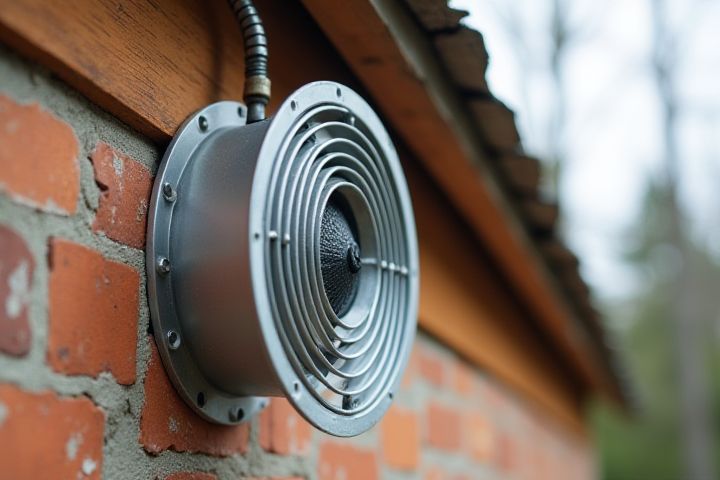
To effectively ventilate a house, consider utilizing natural methods such as opening windows and doors to promote cross-ventilation, allowing fresh air to replace stale air. Ceiling fans and exhaust fans in kitchens and bathrooms are also essential in removing humidity and odors, enhancing air circulation throughout your home. Installing air vents and utilizing air purifiers can significantly improve indoor air quality by filtering out allergens and pollutants. Regularly maintaining HVAC systems and changing air filters ensures optimal performance and efficient airflow. For energy efficiency, consider timed ventilation strategies that align with your household activities and weather patterns.
How To Ventilate A House
Open windows and doors
Opening windows and doors is an effective method for enhancing indoor air circulation, promoting a healthier home environment. For optimal airflow, open windows on opposite sides of the house to create a cross-ventilation effect, which can reduce indoor CO2 levels and humidity. In warmer months, try to maintain open windows during cooler parts of the day, like early morning or late evening, to improve air quality without overheating your living space. Ensure that doors leading to rooms with different temperature zones are also opened periodically to equalize air pressure and temperature throughout your home.
Use exhaust fans
Exhaust fans play a vital role in enhancing indoor air quality by effectively removing stale air, moisture, and odors from your home. Installed in areas like kitchens and bathrooms, these fans eliminate excess humidity that can lead to mold growth and structural damage. When using exhaust fans, ensure they vent directly outdoors to prevent re-circulation of indoor pollutants. Regular maintenance, such as cleaning the fan blades and ducts, enhances their efficiency, allowing for optimal air exchange in your living spaces.
Install attic vents
Installing attic vents can significantly enhance your home's ventilation, helping to regulate temperature and reduce humidity levels. Properly positioned attic vents, typically at a ratio of 1 square foot of vent area for every 150 square feet of attic floor space, ensure effective airflow. Choose from options like gable vents, ridge vents, or turbine vents based on your specific attic design and climate conditions. By implementing this simple upgrade, you can improve indoor air quality and prolong the lifespan of your roofing materials.
Utilize whole-house fans
Utilizing whole-house fans can significantly improve your home's ventilation by creating a powerful airflow throughout the space. These fans, typically installed in the attic or ceiling, draw in cooler outdoor air while expelling warm, stale air from the house. To maximize effectiveness, operate the fan during early morning or late evening when outdoor temperatures are lower, which can reduce indoor temperatures by up to 10degF. Ensuring all windows are open allows for optimal air circulation, helping to maintain a comfortable living environment while reducing reliance on air conditioning systems.
Employ ceiling fans
Employing ceiling fans is an effective way to enhance air circulation in your house, particularly during warmer months. A ceiling fan can create a wind-chill effect, making the ambient temperature feel up to 4 degrees cooler. Properly installed and set to rotate counterclockwise, ceiling fans push cool air downwards, aiding in the evaporation of sweat and providing comfort. Ensure your ceiling fans are regularly maintained, as clean blades operate more efficiently, ultimately enhancing your home's overall ventilation.
Keep interior doors open
Keeping interior doors open is a vital strategy for effective house ventilation, promoting air circulation throughout your living space. By allowing airflow between rooms, you facilitate a more balanced temperature and humidity level, optimizing comfort and reducing the risk of mold growth. Studies show that homes with open interior doors can reduce energy costs by 10-15% as they encourage the efficient movement of conditioned air from heating or cooling systems. Ensuring that air can move freely throughout your house can lead to improved indoor air quality, enhancing your overall living experience.
Clean air vents regularly
Clean air vents regularly to ensure optimal airflow and maintain indoor air quality. Over time, dust, allergens, and debris can accumulate in your vents, potentially affecting your health and comfort. For best results, schedule cleaning every 3 to 5 years, or more frequently if you have pets or allergies. By prioritizing this maintenance, you enhance the efficiency of your HVAC system and promote a healthier living environment.
Use air purifiers
Air purifiers play a crucial role in enhancing indoor air quality by removing allergens, pollutants, and harmful particles. When selecting an air purifier, consider those with HEPA filters, which capture at least 99.97% of particles as small as 0.3 microns. To maximize their effectiveness, position purifiers in areas with high traffic or where you spend the most time, such as bedrooms and living rooms. Regularly replace the filters as recommended, typically every 6-12 months, to ensure optimal performance and cleaner air in your home.
Maintain HVAC systems
Maintaining your HVAC system is crucial for effective home ventilation, ensuring optimal indoor air quality and energy efficiency. Regularly replace air filters--ideally every 1-3 months--to prevent dust and allergens from circulating in your living spaces. Schedule professional inspections and tune-ups at least twice a year to identify any potential issues and keep the system running smoothly. Properly sealed ductwork also enhances airflow; consider sealing any leaks to maximize efficiency and reduce energy costs by up to 30%.
Position furniture wisely
Positioning furniture wisely can significantly enhance ventilation in your home. Ensure that large items, such as sofas and armoires, are placed away from air vents and windows, allowing airflow to circulate freely. Utilize lightweight or lower-profile furniture, which can create more space and prevent obstruction of air pathways. Additionally, keeping interior doors open can further promote air circulation, making your living environment more comfortable and reducing humidity levels.
